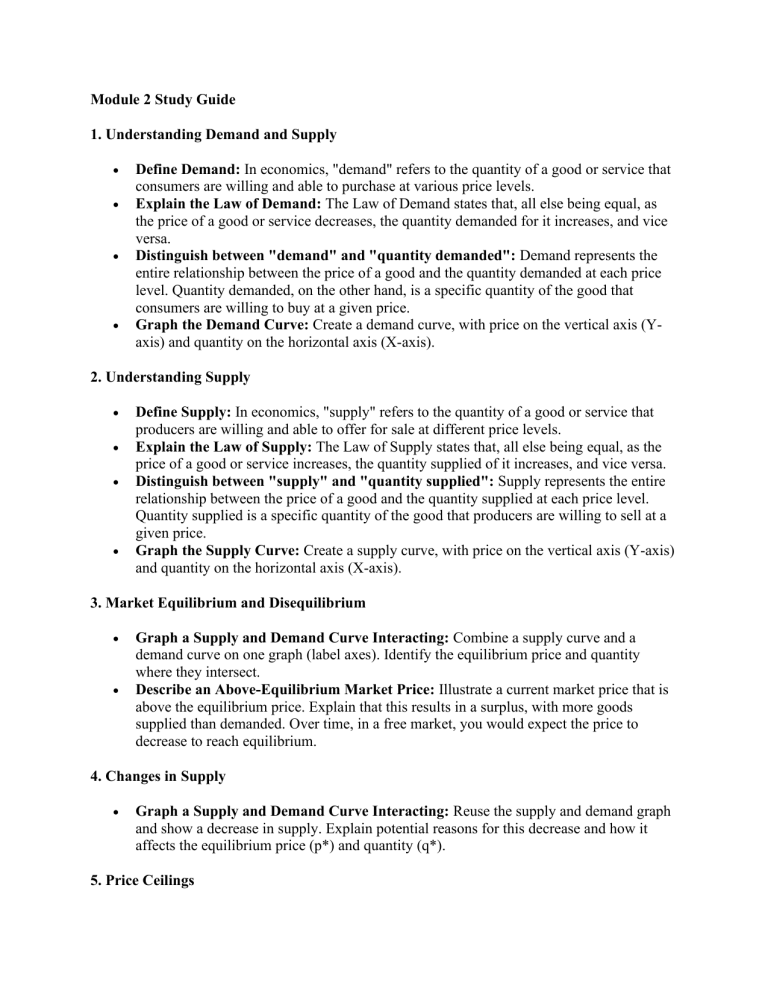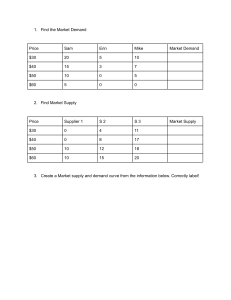
Module 2 Study Guide 1. Understanding Demand and Supply • • • • Define Demand: In economics, "demand" refers to the quantity of a good or service that consumers are willing and able to purchase at various price levels. Explain the Law of Demand: The Law of Demand states that, all else being equal, as the price of a good or service decreases, the quantity demanded for it increases, and vice versa. Distinguish between "demand" and "quantity demanded": Demand represents the entire relationship between the price of a good and the quantity demanded at each price level. Quantity demanded, on the other hand, is a specific quantity of the good that consumers are willing to buy at a given price. Graph the Demand Curve: Create a demand curve, with price on the vertical axis (Yaxis) and quantity on the horizontal axis (X-axis). 2. Understanding Supply • • • • Define Supply: In economics, "supply" refers to the quantity of a good or service that producers are willing and able to offer for sale at different price levels. Explain the Law of Supply: The Law of Supply states that, all else being equal, as the price of a good or service increases, the quantity supplied of it increases, and vice versa. Distinguish between "supply" and "quantity supplied": Supply represents the entire relationship between the price of a good and the quantity supplied at each price level. Quantity supplied is a specific quantity of the good that producers are willing to sell at a given price. Graph the Supply Curve: Create a supply curve, with price on the vertical axis (Y-axis) and quantity on the horizontal axis (X-axis). 3. Market Equilibrium and Disequilibrium • • Graph a Supply and Demand Curve Interacting: Combine a supply curve and a demand curve on one graph (label axes). Identify the equilibrium price and quantity where they intersect. Describe an Above-Equilibrium Market Price: Illustrate a current market price that is above the equilibrium price. Explain that this results in a surplus, with more goods supplied than demanded. Over time, in a free market, you would expect the price to decrease to reach equilibrium. 4. Changes in Supply • Graph a Supply and Demand Curve Interacting: Reuse the supply and demand graph and show a decrease in supply. Explain potential reasons for this decrease and how it affects the equilibrium price (p*) and quantity (q*). 5. Price Ceilings • Graph a Supply and Demand Curve Interacting: Continue using the same graph and introduce an effective price ceiling. Provide a reason for why the government might impose such a law. Clarify that a price ceiling can lead to a persistent shortage in the market. 6. Consumer and Producer Surplus • Identify Surplus Areas: On your supply and demand graph, point out the areas representing consumer surplus and producer surplus. Explain how these areas signify gains from trade for buyers and sellers. 7. Deadweight Loss • • Define Deadweight Loss: Deadweight loss represents the loss of economic efficiency in a market due to factors like price floors or ceilings. Graph Deadweight Loss: Create a graph showing deadweight loss (label axes) and explain how a price floor or price ceiling can result in deadweight loss by causing inefficient market outcomes. 8. Labor Market • • Graph the Labor Market: Draw a graph with wage rate on the vertical axis and the quantity of labor on the horizontal axis. Increase in Demand for Labor: Show an increase in demand for labor and explain potential reasons for this increase. Discuss the impact on equilibrium labor hired (L*) and the equilibrium wage rate (w*). 9. Loanable Funds Market • • Graph the Loanable Funds Market: Create a graph with interest rate on the vertical axis and the quantity of loanable funds on the horizontal axis. Increase in Savings Rate: Illustrate an increase in the savings rate by households. Explain how this affects the equilibrium amount of loanable funds loaned (LF*) and the equilibrium interest rates (r*).







